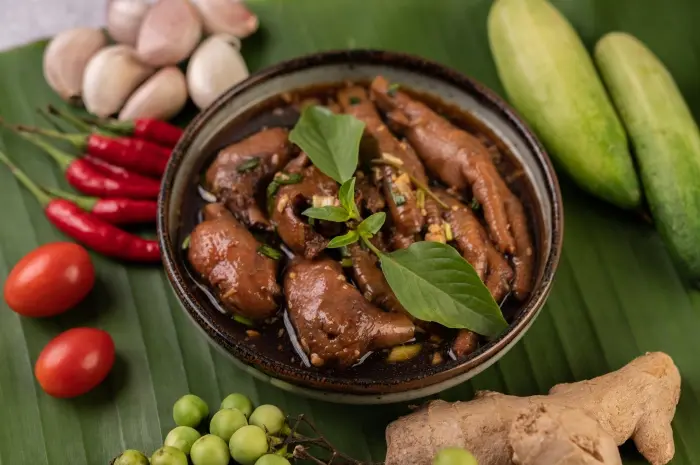Discover a variety of mouth-watering Filipino specialties, from unique dishes like balut to chicken adobo, bringing authentic Filipino flavors to your dining table.
The Philippines, an archipelago renowned for its natural beauty, also has a rich culinary heritage. Filipino cuisine combines unique flavors, uses fresh, local ingredients, and often has strong, bold flavors.
From spicy dishes to more extreme dishes, the Philippines offers an unforgettable culinary experience. Here are 10 Filipino specialties you must try.
Also Read
1. Chicken Adobo
Adobo is one of the most famous dishes in the Philippines, and almost every family has their own way of making it. Known as “ chicken adobo,” this dish is essentially chicken cooked in a marinade consisting of soy sauce, vinegar, garlic, bay leaves, and pepper.
The long cooking process allows the spices to perfectly penetrate the chicken, creating a distinctive and rich flavor. As a Typical Philippines Food, adobo was originally made using pork, but chicken has become a popular alternative in more modern times.
The salty and slightly sour taste of soy sauce and vinegar gives a very appetizing impression. What makes adobo unique is the marinating technique that gives it a different taste from regular chicken dishes, making it a very popular food among locals and tourists alike.
2. Lechon Pork
Lechon pork is a staple food in many celebrations in the Philippines. This whole roasted pork is smeared with various spices, giving it a savory and delicious taste.
The roasted pork has a crispy skin on the outside and very tender meat on the inside. This food is very popular at big events such as weddings, birthdays, and other celebrations.
This dish is similar to Balinese roast pork, but with unique Filipino spices and roasting techniques. Lechon pork is often served with sauce or rice to add to the enjoyment.
3. Wrap
For some people, balut may be quite an extreme food, but in the Philippines, balut is a very popular food. This food is made from fertilized duck eggs that are around 18 to 21 days old.
After the egg is boiled, the contents, which are already in the form of an embryo, are sure to have a unique texture and quite a strong taste.
Balut is usually eaten with salt and vinegar to add flavor. Many Filipinos believe that balut has health benefits, such as increasing vitality. Although it may seem a bit ridiculous to some, balut remains a common food found in many night markets and streets in the Philippines.
4. Inasal Chicken
If you’re looking for a lighter, simpler chicken dish, try chicken inasal. Chicken inasal is a Filipino grilled chicken seasoned with a fresh blend of spices, including calamansi (a Filipino citrus), garlic, ginger, and soy sauce. The process of grilling the chicken This gives a very delicious and juicy taste.
This dish is very popular in the Visayas region, especially in Bacolod City, known as the capital of chicken inasal. The well-seasoned spices make chicken inasal a very appetizing dish, whether for lunch or dinner.
5. Kare Kare
Kare-kare is a Filipino curry dish made from various vegetables such as string beans, eggplant, and pumpkin, as well as beef, lamb, or cow’s feet. What makes kare-kare different from other curries is its sauce made from peanut butter, giving it a milder and slightly sweeter taste.
This dish is usually served with white rice and a side dish of bagoong (fermented shrimp paste). Kare-kare is a food that is rich in flavor and is perfect for lunch with family or friends.
6. The Guisado Pancit
Pancit guisado is one of the most loved noodle dishes in the Philippines. This dish consists of noodles cooked with various ingredients, such as chicken, shrimp, vegetables, and sometimes pork. The seasonings used in pancit guisado include sweet soy sauce, salt, and fish sauce, which give it a strong savory flavor.
Pancit guisado is often served at birthday celebrations and special occasions, as it is thought to bring good luck. This dish is one example of Filipino food that is very easy to adapt to everyone’s taste.
7. Kinilaw
Kinilaw is a raw seafood dish similar to ceviche, but distinctly Filipino. This dish is made from fresh tuna, which is cut into small pieces and soaked in orange juice.
In addition, Kinilaw is often flavored with spices such as shallots, garlic, and ginger, as well as vegetables such as cucumber and carrots.
Known as one of the oldest dishes in the Philippines, kinilaw has a fresh and slightly sour taste, perfect as an appetizer or a casual snack.
8. Rice porridge
Arroz caldo is a rice porridge that is very popular in the Philippines, especially during the rainy season or when people are feeling unwell.
This porridge is made from rice cooked with chicken stock, ginger, and garlic. Usually, arroz caldo is served with pieces of chicken, boiled eggs, and fried onions as accompaniments.
This porridge has a smooth, rich taste and is very comforting. Paired with fish sauce or seafood, arroz caldo is a great choice for a light lunch or dinner.
9. The Greatest Showman
Paksiw na bangus is a fish dish that uses bangus fish (milkfish) cooked in a mixture of vinegar, garlic, ginger, and spices. The fish is then cooked until tender, so it tastes very savory and fresh. Paksiw na bangus is often served with warm white rice and some vegetables as a complement.
This dish is very popular in the Philippines, especially in the areas of Bataan and Dagupan, which are known to produce the best bangus in the country.
10. Wrap
Balut is another extreme food in the Philippines made from fertilized duck eggs that are about 18 to 21 days old. The embryo that develops in the egg gives it a very different texture from a regular egg. Usually, bluff is eaten with a little salt and vinegar to give it a more delicious taste.
Although it may sound strange to some people, balut is a food that is rich in protein and is considered a food that has many health benefits, including for body vitality.
Filipino cuisine offers a variety of flavors that are very distinctive, with a variety of unique spices and cooking techniques. From the rich chicken adobo to the challenging balut, each dish provides a deep and different culinary experience.
If you are planning to visit the Philippines, be sure to try these signature dishes, and don’t forget to bring home Typical Philippines Souvenirs to share a piece of the local culture and rich culinary traditions.














